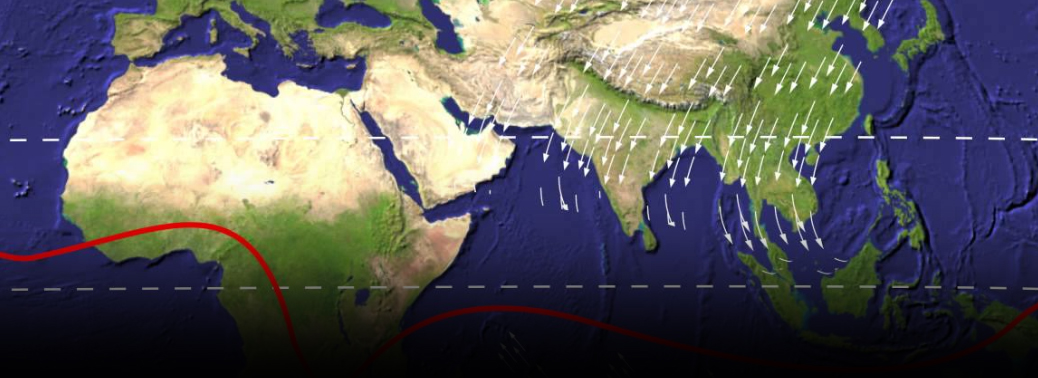EYE ON THE MONSOON
21, May 2019

Prelims level : G2A Physical setting
Mains level : GS1L Geophysical Phenomena
Why in News:
- The India Meteorological Department has forecast normal rainfall of 96% of the long period average of 89 cm rain in Kerala. It has also signalled a significant possibility of a deficit.
Details:
- India waits for the arrival of the annual summer monsoon, hopes are high for normal rainfall that is so vital for agriculture, the health of forests, rivers and wetlands.
- The monsoon is crucial for the 60% of gross cropped area in farming that is rain-fed and in the assessment of the National Commission on Farmers which has 45% of agricultural output. Some aerosols suppress the rainfall and disperse it across the land, causing long breaks in precipitation, while others absorb heat and lead to a convection phenomenon that increases rainfall in some places.
Way forward:
-
The southwest monsoon is a determinant of India’s overall prosperity, and sustained efforts
to make the best use of rainfall are absolutely important for farms, cities and industry. - There has been a 52% decline in groundwater levels. State governments should have pursued the setting up of new recharging wells and made improvements to existing ones on a war footing.
- There is a lag in building structures to harvest surface water and helping farmers raise the efficiency of irrigation.
- India needs to clean up its act on rising industrial emissions, and burning of fossil fuels and biomass in order to improve the stability of the monsoon.
-
NITI Aayog says that freshwater availability for households, account for 4% of available supplies, besides 12% used by industry.
Urbanisation trends and the severe water stress that residents experience underscore the need for mandatory rainwater harvesting policies and augmented efforts by States to preserve surface water by building new reservoirs.
Monsoon:
- Monsoon is the lifeline of Indian economy as 2/3rd of it depends on farm income and rain is the only source of irrigation for over 40% of the country’s cropped area.
- Over 70% of India’s annual rainfall occurs in July-September monsoon season.
- A good monsoon increases crop productivity, raises farm income and drives the economy while, a weak monsoon inflates food prices and harms the economy.
- Monsoon refers to the seasonal reversing wind accompanied by precipitation.
- It occurs due to a difference in temperature between the landmass and the ocean. Major monsoon of the world are West African and Asian-Australian monsoons.
- Southwest monsoon accounts for over 80% of rainfall in India. Monsoon impacts Indian economy- agriculture, industry and society as a whole. It brings respite from heat and transforms large part of semi-desert areas into green land.
- Crops specially like cotton, rice, oilseeds, and coarse grains depends heavily on rains.
- Monsoons are often associated with conditions like ‘El Nino’ (Spanish for ‘Little Boy’) that occurs every 2 to 7 years and La Nina. It is caused by unusual warming in Eastern tropical Pacific Ocean and reversal of prevailing winds in the region. El Nino can trigger above average rains in northern Peru & draught in Southeast Asia, Australia and India.
Southwest monsoon/ Indian monsoon:
- Indian subcontinent has a large heated landmass during the summer months (April to September), and a cooler water mass in the form of Indian Ocean.
- This causes a temperature difference, which creates a pressure gradient and drives moisture laden winds over Indian subcontinent. Impact of this monsoon is felt in India, Sri Lanka, Bangladesh and Myanmar and as far north as in China’s Xinjiang.
- It has two branches:
The Arabian Sea branch:
- It first hits the Western Ghats and Kerala gets the first rain in India. It causes rain in the coastal areas of Konkan and Goa
As it moves northwards, but eastern part of the Western Ghats do not receive much precipitation.
The Bay of Bengal Branch:
- It picks up moisture-laden winds from Bay of Bengal and moves towards North-East India and Bengal. The Himalayas act as a barrier for them and thus, rain occurs in Indo- Gangetic plains, Meghalaya, etc.
Northeast monsoon/ Retreating monsoon:
- The cycle is reversed during colder months (October to April). Wind blows from cooler landmass (Himalayas and Indo-Gangetic plain) towards Indian ocean (south of Deccan). This causes precipitation over the oceans and in regions like Tamil Nadu.






